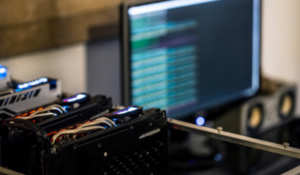 Once you have familiarised yourself with our beginner's guide to cryptocurrency you may want to find out how cryptocurrencies are created, and what options you have to join in and make some crypto coins of your own. Despite being household name in the finance world, many people still find it difficult to get to grips with the technical jargon that comes hand-in-hand with cryptocurrency. This article will explain the sometimes complex working of the digital currency world to help you get to grips with a hugely popular and growing market.
Once you have familiarised yourself with our beginner's guide to cryptocurrency you may want to find out how cryptocurrencies are created, and what options you have to join in and make some crypto coins of your own. Despite being household name in the finance world, many people still find it difficult to get to grips with the technical jargon that comes hand-in-hand with cryptocurrency. This article will explain the sometimes complex working of the digital currency world to help you get to grips with a hugely popular and growing market.
What is cryptocurrency mining?
Unlike flat currency (such as USD or GBP), which can simply be printed or minted to create more, cryptocurrency can only be made through the process of 'mining'. Cryptocurrency mining is the name given to the process in which new crypto coins are generated and entered into circulation. It is also a crucial part of maintaining and developing the public ledger of any digital currency. Essentially, cryptocurrency mining forms a self-rewarding cycle as 'miners' maintain and secure the blockchain, the blockchain rewards those miners with coins for their work, and those coins provide an incentive for more miners to contribute to maintaining the blockchain.
Mining cryptocurrencies is time-consuming, expensive, and the reward is not necessarily equal to the effort put in. However, it does enable miners to generate more digital currency to add to their holdings, so it can be an appealing option for those with the resources to do it.
How does cryptocurrency mining work?
The process of mining cryptocurrency involves using sophisticated computer software to perform complex mathematical tasks. For example, in the case of bitcoin, the first part of the process involves recording and verifying the legitimacy of bitcoin transactions. The second part involves solving a complex mathematical puzzle relating to those transactions, which is referred to as "proof of work".
The answer to the mathematical puzzle for a given set of transactional data is a 64-digit hexadecimal number (also called a "hash"). Every miner competes to be the fastest to guess this figure, and the winner is permitted to update the blockchain ledger with a new "block" of newly-verified transactional data, for which the reward is a predetermined amount of cryptocurrency. With bitcoin mining, a winner is announced on average every ten minutes with a reward of 3.125 bitcoin per verified block. This is how new bitcoins are created.
However, bitcoin rewards are reduced by half after every 210,000 blocks mined, which occurs roughly every four years. That means that the reward is set to be reduced by half in 2028 and this will continue until the total amount of coins in circulation reaches the final cap of 21 million, which is not expected to happen until the year 2140. The cap is designed to keep bitcoin immune to inflation. In addition, the mathematical problem is also designed to become harder to solve as the number of miners increases in order to keep the production of new blocks and therefore bitcoin stable.
As well as this reward miners earn for finding the hash and creating a block, they receive a small fee (again in bitcoins if we are talking about the bitcoin blockchain) from the transactions that are included in their new block.
The whole mining process is designed to make the generation and acquisition of cryptocurrency as fair as possible. The cryptocurrency mining process is attractive enough to provide a reward to miners that helps to improve and maintain the security of the entire blockchain, with each verified block contributing to a vast, theoretically infallible ledger of transactional data.
What are the different methods of mining cryptocurrencies?
Cryptocurrency mining can be performed by just about anyone, but it does require a robust computer (almost all laptops will struggle to cope with the sheer volume of data) and a large electricity supply.
There are a number of different methods for mining cryptocurrency, however, and each has its own advantages and disadvantages. Below, we walk you through the basics of each mining process, and explain the pros and cons of each.
Cloud Mining
Cloud mining is one of the most popular ways of mining cryptocurrency. It can work one of two ways. One way involves paying someone (usually a large corporation) a specific amount of money to 'rent out' their mining machine – which is called a “rig” – so that the miner can use it. You are then responsible for the machine and its performance. This can involve an expensive upfront outlay.
Alternatively and more commonly, cloud mining services allow you to rent their computing power from their mining farms. These mining farms are huge stockpiles of advanced computers, located around the world. You then share in the rewards that the farm generates from mining in proportion to the amount of computer power (called "hash power") you rent. In effect, you are part-funding a huge mining operation.
The rent period for cloud mining is agreed between the miner and the renter, and your share of the earnings the farm makes are transferred directly to your cryptocurrency wallet.
Different corporations offer different cloud mining rent plans according to the services available to the miner, but most rent plans fall between £350 to £3,500, and miners can usually sign up for anywhere from two years to an entire lifetime.
There are also free versions of cloud mining, but the service tends to be much slower and therefore less likely to be the first to guess that all-important 64-digit hash.
Cloud mining has proved so popular in recent years because it enables miners that do not ordinarily have access to computers that can perform cryptocurrency mining, which includes most ordinary members of the public, to rent someone else's without having to purchase their own extremely expensive piece of technology.
GPU Mining
GPU mining uses a computer's in-built graphics processing unit in order to perform the complex mathematical tasks required for a cryptocurrency reward. It is probably the most widespread and well-known method of mining cryptocurrencies. Cloud miners already access GPU rigs, except they rent usage rather than own one themselves.
Although the construction of the rig itself tends to be costly, it can end up paying for itself due to its speed at generating hashes, making a miner with a GPU rig significantly faster at generating new blocks and thus earning cryptocurrency coins.
A standard GPU rig is made out of a processor, a motherboard, a cooling system, rig frame, and a number (usually 2 - 8) of advanced graphics cards.
A typical market price for a GPU mining rig tends to be around the £2,000 mark. It can seem like a daunting investment upfront, but in theory, it will pay off much faster than some of the slower alternatives.
CPU Mining
CPU mining utilises advanced computer processors to mine cryptocurrency. It used to be a popular option during the first few years after cryptocurrency was established, but fewer miners currently opt for this method due to the significant disadvantages compared to the more efficient methods available now, such as cloud or GPU mining.
Above all, CPU mining is extremely slow, and you could find yourself mining for months without gaining any revenue. The fact that it is such a long process means that it often uses more electricity over this period, which can rack up hefty bills unless you have access to cheap electricity and cooling systems (cryptocurrency mining is so taxing on computers that it can cause them to overheat without adequate cooling apparatus).
The reason CPU mining used to be popular was because all it required was a computer and some software programs. In the early days of cryptocurrency, it was even possible for an ordinary laptop to compute some mining processes, but the sheer processing power needed for handling current blockchain data – which grows even further with each block contributed – would almost certainly crash even a high-spec laptop today.
Despite this, the ease of CPU mining continues to attract thousands of new miners every year, but usually only in places where electricity is a comparatively cheap commodity.
ASIC Mining
ASICs (Application-Specific Integrated Circuits) are devices that are designed explicitly to perform a single task, in this case cryptocurrency mining, and are known for being able to produce significantly more cryptocurrency than alternative mining methods because they are optimised purely for this purpose. They are, however, rather controversial in the cryptocurrency community. Some have even called for a ban on ASIC machines altogether. Their sheer computing power means that they essentially have a monopoly on hashes, with miners restricted to GPU or CPU rigs generally unable to keep up with the speed and efficiency of an ASIC.
In some cases, ASICs have completely monopolised the economy of a certain cryptocurrency – such as Zcoin – with the majority of new coins handed out to miners with access to ASIC farms. This gives them almost incontestable control over most of the currency. Most ordinary miners do not use ASICs, however, with some second-hand models fetching prices of more than £3,000.
What about the electricity costs from mining cryptocurrency?
Due to the infinitely-increasing complexity of blockchains, mining cryptocurrencies requires far greater processing power than it did even a couple of years ago, and thus utilises a large amount of electricity.
Recent data suggests that bitcoin mining alone already reached an all-time high of 149 terawatt-hours (TWh) during 2020, compared to the entirety of Google using just 12.2 TWh over the same period.
"If bitcoin was a country, it would use around the same amount of electricity a year to mine as Switzerland does in total," Deutsche Bank analysts warned in May 2021.
Cambridge’s Centre for Alternative Finances has estimated that a single transaction of bitcoin has the same carbon footprint as 680,000 Visa transactions or 51,210 hours of watching YouTube.
Not only does the sheer volume of electricity needed to mine cryptocurrency make it an extremely expensive endeavour for an ordinary miner, but its overall energy usage has also attracted criticism from climate campaigners who point out that the majority of this electricity is generated through the use of fossil fuels.
It is not yet clear what impact this will have on the cryptocurrency mining industry as a whole, but if it is to advertise itself as a viable future alternative to traditional money, then steps must be taken to decrease its carbon footprint.
What is the best way to mine cryptocurrency?
Ultimately, the cryptocurrency mining method which suits you the most depends on a number factors.
Are you willing to spend some initial money upfront? If so, are you limited to a couple of hundred pounds, or do you have enough to afford a GPU or ASIC of your own? Do you even want to own your own rig, or would you rather rent from someone else's mining power via a cloud service?
Generally, though, GPU rigs and cloud mining seem to be the most popular options for ordinary cryptocurrency miners. CPU mining tends to be too slow, while ASICs can be expensive and could well be prohibited in the future. If you do use your own rig then it is worth looking into joining a mining pool, which is where you join forces with a group of miners to share computing power and therefore any rewards. Well known bitcoin mining pools include Slush pool.
Alternatively, if you do decide to get into mining pay attention to your electricity budget, as not only is cryptocurrency mining already expensive, it is likely to become even more so in the coming months and years.
For those concerned about the environment, cryptocurrency mining does not yet use enough renewable energy sources to offset its heavy carbon footprint, so it may be worth keeping in mind the current impact of mining on fossil fuel production.
More on crypto
Make sure to check out our list of the best cryptocurrency exchange platforms in the UK, our step-by-step guide on how to buy bitcoin, and our explainer on what cryptocurrency wallets are before you dip your toes into crypto investing.




